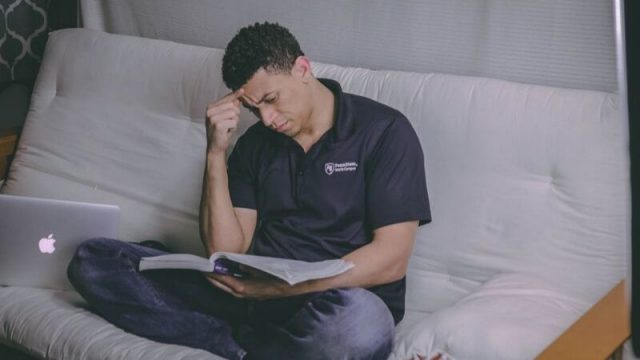Advertiser Disclosure
How To Ace Student Loan Forgiveness
Updated On September 22, 2022
Editorial Note: This content is based solely on the author's opinions and is not provided, approved, endorsed or reviewed by any financial institution or partner.

For many student loan borrowers, student loan forgiveness seems like an elusive golden ticket to financial freedom. That's why it's essential that you learn how to ace student loan forgiveness.
For those that qualify, student loan forgiveness programs can be confusing and difficult to navigate.
What are student loan forgiveness programs available? How do you apply? Will you qualify? Will your student loans really be forgiven?
The good news is that there are multiple ways to have your student loans forgiven – partially or in full.
Here is what you need to know about student loan forgiveness:
1. Student Loan Forgiveness: The Status Quo
Today, the standard student loan repayment period is 10 years. However, the federal government created several income-driven repayment plans (including PAYE and REPAYE) to help make student loan payments more affordable for borrowers who cannot afford their monthly payment.
Under the Pay As You Earn (PAYE) and Revised Pay As You Earn (REPAYE) income-driven repayment plans, you pay 10% of your discretionary income each month toward your federal undergraduate student loans for 20 years, at which point any remaining balance on your federal undergraduate student loan is forgiven.
Under REPAYE, if you have graduate school student loan debt, the repayment period is 25 years before your remaining student loan debt is forgiven.
2. Student Loan Forgiveness: President Trump’s Plan
On October 13, 2016, Trump proposed an income-based repayment plan that allows borrowers to cap their monthly student loan payments based on their income and then have their student loans forgiven after a certain period of time.
Under Trump’s plan, if you are a student loan borrower, your monthly student loan payments would be capped at 12.5% of your income. After 15 years of monthly payments, your remaining student loan debt would be forgiven.
While Trump’s proposal raises the monthly payment cap from 10% to 12.5% of income, his proposal forgives the remaining student loan balance five to 10 years sooner than the current income-driven repayment plans.
3. Public Service Loan Forgiveness
Through Public Service Loan Forgiveness, public servants can have 100% of their student loans forgiven after 120 eligible on-time monthly payments.
At this time, however, the future of Public Service Loan Forgiveness is uncertain. President Trump’s most recent budget proposal calls for the elimination of the Public Service Loan Forgiveness for new loans originated after July 1, 2018.
There are several possibilities regarding Public Service Loan Forgiveness, including, among others:
- The Public Service Loan Forgiveness program continues in its current form
- Congress eliminates the Public Service Loan Forgiveness program
- Congress eliminates Public Service Loan Forgiveness and places all borrowers into a single income-based repayment program such as the 15-year student loan forgiveness program that Trump proposed
- Congress could cap the amount of Public Service Loan Forgiveness
- Congress could restrict the employment fields that qualify for Public Service Loan Forgiveness
- Congress could establish a means test to qualify for Public Service Loan Forgiveness
Although not guaranteed, if the current Public Service Loan Forgiveness changed or were eliminated, existing student loan borrowers likely would be grandfathered in, since they borrowed with the expectation of entering public service and qualifying for loan forgiveness.
This Public Service Loan Forgiveness Calculator can help you calculate your total potential student loan forgiveness.
4. Teacher Student Loan Forgiveness
Teacher Student Loan Forgiveness is for full-time teachers with five complete and consecutive years of teaching experience in a designated elementary or secondary school, or educational service agency, that serves students from low income families.
Teachers with federal Direct Loans or Stafford Loans are eligible to have up to $17,500 forgiven if they are highly-qualfied full-time math or science teacher in an eligible secondary school. Elementary or secondary school teachers who teach in an area related to their academic major are eligible to have up to $5,000 forgiven. Student loans that were originated prior to October 1, 1998 are not eligible.
5. Perkins Student Loan Cancellation
Public servants also can have up to 100% of their Perkins student loans cancelled.
Qualified public servants for Perkins student loan cancellation include, among others, members of the armed forces who served in a hostile fire or imminent pay danger area, firefighters, law enforcement and corrections officers, teachers, nurses, medical technicians, public defenders and VISTA or Peace Corps volunteers.
6. Student loan refinancing is a secret student loan forgiveness tool
What do student loan refinance and student loan forgiveness have in common?
More than you think.
While the federal government forgives student loans, the federal government does not refinance them.
Student loan refinancing is made possible through private financial lenders who can offer both fixed and variable interest rates below the current interest rates on your federal student loans.
Why? Every borrower receives the same interest rate on a federal student loan – regardless of his or her credit profile. If you have a strong credit profile, effectively you are paying more for your student loans from the federal government based on your underlying credit risk as a borrower.
When you borrowed your student loans as a full-time student, you likely did not have the credit history or income to receive a low interest rate. Now that you have graduated and have work experience and a stable income, lenders are more willing to lower your interest rate.
Private lenders will underwrite you based on your personal credit profile, income, cash flow and other financial factors. If you have strong credit, stable income and sufficient cash flow to pay your debt, a private student lender can refinance your student loan at a lower interest rate.
For example, let’s assume that you have $100,000 of student loan debt at a 6% interest rate. (Many student loan debt borrowers have student loan debt at even higher interest rates). Today, if you have a strong credit profile and sufficient income, you can refinance student loans with some lenders at 2.5% (or lower).
In this example, if you repay your student loans in 10 years, you could save over $20,000 from refinancing your student loans.
This student loan refinancing calculator shows you how much money you can save by refinancing your student loans. You can calculate both your new monthly payment and total savings.
By refinancing your student loans, you can wipe out a chunk of interest that you otherwise would have had to pay.
Consider these cost savings a form of “student loan forgiveness.”



